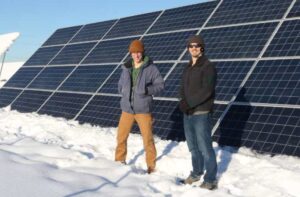
Golden Valley Electric Association’s Nathan Minnema, right, and ACEP intern Dan Manley stand in front of one of 40 solar panels that made up the utility’s 563-kilowatt solar farm in 2019.
A new report by the University of Alaska Fairbanks’ Alaska Center for Energy and Power provides a roadmap for future developments of community solar.
Community solar is an ownership model that allows multiple customers to buy, lease or subscribe to a portion of a solar array or the energy it generates. Unlike traditional net-metered solar power, which is installed on the customer’s property, a community solar array can be located virtually anywhere within the utility service area.
The report provides an overview of the current solar policy landscape, market conditions and various financing and ownership models, offering valuable insights into the future of community solar in Alaska.
“Community solar has a great potential to reduce energy cost for Alaskans,” said Shivani Mathur Bhagat, the lead author of the report and a research assistant professor at ACEP, specializing in energy policy and economics.
While there is consumer and utility interest in community solar, Alaska currently does not have any implemented project.
This could soon change.
“It is a conducive time for community solar projects in Alaska,” Bhagat said.
Multiple government actions encourage community solar projects, including federal Inflation Reduction Act tax incentives, federal Solar for All funding and the recently passed Alaska Senate Bill 152. SB 152 directs electric utilities to support community solar projects, while allowing flexibility in project design and execution.
“This report is timely because currently there is a momentum building for CS, which can lead to implementation of on-the-ground projects in the state,” Bhagat said. “Utilities, industry players and communities should be considering modeling possible projects in the light of existing opportunities.”
The report highlights the opportunities and challenges for scaling up community solar in Alaska, such as attracting private sector investment, meeting workforce needs and leveraging federal and state incentives.
Read the full report, “Scaling Up Community Solar in Alaska.” Authors include Bhagat, Michelle Wilber and Steve Colt, all with ACEP, and Christopher Pike, formerly with ACEP. Funding for the report was provided by an Alfred P. Sloan Foundation grant led by the University of Vermont.
